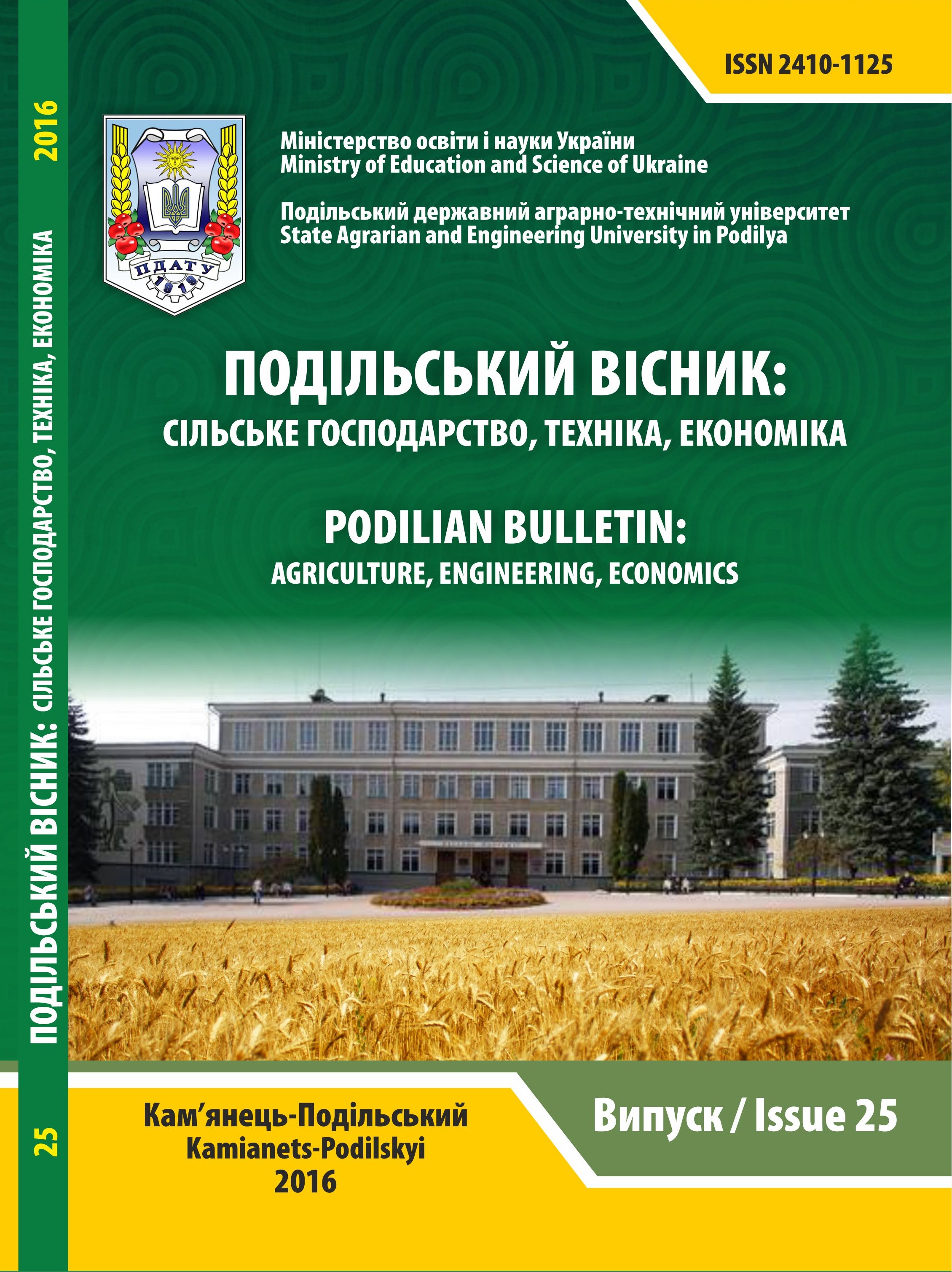Segetal Vegetation of Soybean Crops Underthe Influence of Biological and Chemical Preparations
Keywords:
soybeans, herbicide, plant growth regulator, microbiological agent, weedsAbstract
The results of observations concerning the impact of different rates of herbicide Fabian (90;100 and 110 g/ha); plant growth regulator Rehoplant (250 ml/t preplanting seed cultivation; 50 ml/ha – postgermination application) and microbiological preparation Ryzobofit (100 ml/t seeds) on segetal vegetation of soybeans were established. The optimal rates and ways of application of preparations promoting the most effective quantity and weight reduction of segetal vegetation in soybean crops were determined. This arrangement provides effective control of segetal vegetation in crops of soybeans resulting increase competitiveness. 30 days after the introduction of preparetion were recorded the highest percentage of destroyed weeds was observed for use in crops of soybeans herbicide Fabian in rates 90; 100 and 110 g/ha together with plant growth regulators Rehoplant normal 50 ml/ha; made against the backdrop of pre seed treatment mixture Ryzobofit with Rehoplant and where the number of weeds was destroyed by the number 91; 92 and 92% by weight – 90; 90 and 91% respectively. Accounting segetal vegetation soybean crops before harvest showed that the highest percentage of weeding provide options experiment combined use of herbicide Fabian 90–110 g/ha of plant growth regulators Rehoplant against the background pre-treatment of seeds Ryzobofit microbiological agents in combination with plant growth regulators Rehoplant where it was noted fewest weeds 12-10 pcs./m2 with weight 100;6–95;3 g/m2; corresponding to the number destroyed them up to 90–92%; and weight – 89–90%.References
Derev'yanskyy, V.P. (2012). Performance of soybean depending on the application of microbiological agents and herbicides. Quarantine and protection of plants, 4, 16‒18.
Didora, V.G., V'yuntsov, S.M., Tyshkovskyy, V.V. et al. (2015). Photosynthetic activity and performance fibred flax depending on foliar feeding. Bulletin. sta. science, v. 2, 240‒245.
Storchous, I. (2015). Side effects of herbicides. Proposition, 7‒8, 91‒94.
Ivasjuk, Y.I., Karpenko, V.P., & Grytsaenko, Z.M. (2015). Symbiotic condition of crops for the action of biologically active substances. Bulletin of Uman National University of Horticulture, 2, 13‒16.
Fedorenko V.P., & Hrykun O.A. (2008). Recommendations for soybean crop protection from pests, diseases and weeds. Guide of Ukrainian farmer, 1, 142‒148.
Krasylovets J.G., Zuza V.S., …Petrenkova V.P. (2006). Optimize the integrated protection of crops. X: Magda LTD.
Hutyanskyy, R.A. (2008). The competitiveness of soybean varieties with different length of growing season with regard to weeds. Breeding and Seed: UAAS Collection, V. 95, pp. 266‒272.
Karpenko, V.P., Grytsaenko, Z.M. … Prytulyak, R.M. (2012). Biological basis of integrated action herbicides and plant growth regulators. Uman.
Karpenko, V.P., & Mostov'yak, I.I. (December 3-5, 2008). Influence of integrated use of herbicides and biological agents on weediness of crops of spring barley. Papers presented on All-Ukrainian meeting of young scientists and specialists. Kyiv "circulation", 51‒52.
Grytsaenko, Z.M., & Pidan, L.F. (2014). Weediness and yield of sunflower crops in various ways to use herbicides Dual Gold 960, 150 Fyuzylad Forte and plant growth regulator Radostim. Bulletin of Uman National University of Horticulture, 2, 54‒59.
Grytsaenko, Z.M., Karpenko, V.P., & Prytulyak, R.M. (2013). Weediness of winter triticale crops for action against the cereal herbicide Super Puma and plant growth regulator Biolan. Bulletin of Uman National University of Horticulture, 1‒2, 20‒25.
Chernega, A. (2012). Biological processes and productivity of crops of winter barley for herbicide Calibre and plant growth regulator Biolan (Unpublished doctoral dissertation): Uman [in Ukr].
Holodryha, O.V., & Grytsaenko, Z.M. (2004). Weeds in crops of soybeans. Quarantine and Plant Protection, 8, 11‒12. [in Ukr].
Triebel, S.O., Sihar’ova, D.D., Skakun, M.P. et al. (2001). Methods of testing and use of pesticides. Kyiv : Mir. [in Ukr].
Downloads
Published
How to Cite
Issue
Section
License
Copyright (c) 2019 Podilian Bulletin: Agriculture, Engineering, Economics

This work is licensed under a Creative Commons Attribution-NonCommercial 4.0 International License.
Authors contributing to Public Policy and Administration agree to publish their articles under a Creative Commons Attribution-NonCommercial 4.0 International (CC BY-NC 4.0) License, allowing third parties to share their work (copy, distribute, transmit) and to adapt it, under the condition that the authors are given credit, and that in the event of reuse or distribution, the terms of this licence are made clear.



